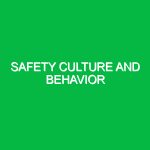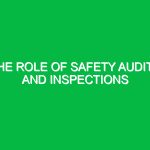Introduction
In the realm of Health, Safety, and Environment (HSE), the phrase “reporting near misses and hazards” holds significant weight. But what does it truly mean? Essentially, it refers to the process of documenting incidents or situations that could have potentially led to accidents or injuries but did not. This proactive approach is crucial in preventing future occurrences. Understanding the nuances of reporting near misses and hazards is not just a regulatory checkbox; it’s an essential practice that can save lives and foster a culture of safety within organizations.
Consider this: a worker is carrying a heavy load and almost loses balance but manages to regain control just in time. This near miss, if reported, can lead to an evaluation of lifting techniques or even a review of safety equipment. The value lies in identifying and addressing the factors that contributed to the near miss, ultimately creating a safer work environment. But beyond individual incidents, the collective reporting of near misses can highlight systemic issues, offering organizations a roadmap for improvement. This guide will delve into the importance of reporting near misses and hazards, the associated risks, safety precautions, best practices, and relevant regulations.
Understanding Hazards and Risks in Reporting
To effectively report near misses and hazards, it’s essential to first comprehend what constitutes a hazard and the risks associated with it. A hazard is any source of potential damage, harm, or adverse health effects on a person or persons. Risks, on the other hand, relate to the likelihood that a person may be harmed or suffers adverse effects if exposed to a hazard.
Types of Hazards
Hazards can be broadly categorized into several types:
Physical Hazards
These are environmental factors that can cause harm. For instance, unguarded machinery or slippery floors can lead to physical injuries. The risk escalates when workers are unaware or inadequately trained to recognize such hazards.
Chemical Hazards
Exposure to harmful chemicals can pose serious health risks. For example, improper storage of hazardous materials can lead to spills or leaks, endangering employees and the environment.
Biological Hazards
These are biological substances that pose a threat to the health of living organisms. An example would be exposure to bacteria or viruses, which can occur in healthcare settings or during pandemics.
Ergonomic Hazards
Poor workplace design can lead to musculoskeletal injuries. Repetitive motion or prolonged awkward positions can result in chronic pain or disability.
Psychosocial Hazards
Workplace stress, harassment, or violence can affect mental health. These hazards are often overlooked but can significantly impact employee well-being and productivity.
The Importance of Reporting Near Misses and Hazards
Why should organizations prioritize the reporting of near misses and hazards? The answer lies in the myriad benefits it offers. Firstly, it fosters a culture of safety. When employees feel encouraged to report incidents without fear of reprimand, it signals that their well-being is valued. This openness can lead to increased engagement and proactive safety measures.
Moreover, reporting near misses and hazards allows organizations to identify trends and root causes of potential accidents. For example, a construction company may notice a pattern of near misses occurring during specific activities, such as lifting heavy objects. This insight could prompt a review of safety protocols or additional training, ultimately reducing the risk of actual accidents.
Another compelling reason for thorough reporting is legal compliance. Many industries are governed by strict regulations that mandate the documentation of such incidents. Failure to comply can result in hefty fines and legal repercussions. For instance, the Occupational Safety and Health Administration (OSHA) in the United States requires employers to maintain a log of work-related injuries and illnesses, including near misses.
Best Practices for Reporting Near Misses and Hazards
Implementing effective reporting practices is essential for any organization aiming to enhance its safety culture. Here are some best practices to consider:
1. Foster a Reporting Culture
Encouragement from leadership is crucial. When management actively promotes reporting, employees feel more comfortable and confident in coming forward. Regular training can also help demystify the reporting process and emphasize its importance.
2. Simplify the Reporting Process
Complex reporting procedures can deter employees from reporting incidents. Simplifying forms and providing multiple reporting channels—such as digital platforms, anonymous submissions, or in-person discussions—can enhance participation.
3. Provide Feedback
After a near miss is reported, providing feedback to the reporting employee is critical. This could involve sharing what actions have been taken in response to their report, thereby reinforcing the value of their input.
4. Conduct Regular Training
Training should not be a one-time event. Regular refresher courses can help employees stay aware of potential hazards and the importance of reporting them. Real-life scenarios and role-playing can make the training more impactful.
5. Analyze and Act on Reports
Collecting reports is just the beginning. Organizations should regularly analyze the data to identify trends and implement corrective actions. This might include revising safety protocols, investing in better equipment, or enhancing employee training.
Safety Precautions for Common Hazards
Understanding hazards is one thing; knowing how to mitigate them is another. Here are some safety precautions tailored to different types of hazards:
Physical Hazards
- Ensure all machinery is equipped with safety guards and emergency shut-off switches.
- Regularly inspect work areas for potential slip, trip, and fall hazards, and address them promptly.
Chemical Hazards
- Implement a robust chemical inventory management system to track hazardous materials.
- Provide comprehensive training on the safe handling, storage, and disposal of chemicals.
Biological Hazards
- Provide appropriate personal protective equipment (PPE) for employees in high-risk environments.
- Implement vaccination programs where applicable, such as flu shots in healthcare settings.
Ergonomic Hazards
- Encourage regular breaks to reduce repetitive strain injuries.
- Invest in ergonomic furniture and tools to promote proper posture and reduce strain.
Psychosocial Hazards
- Establish policies to address bullying, harassment, and workplace violence.
- Provide mental health resources and support for employees.
Regulations and Standards Governing Reporting
The landscape of HSE regulations is vast and varies by country and industry. However, certain regulations stand out in the realm of reporting near misses and hazards:
Occupational Safety and Health Administration (OSHA)
In the United States, OSHA outlines regulations that mandate the reporting of work-related incidents, including near misses. Under OSHA standards, employers must maintain records of injuries and illnesses and report any fatal incidents within eight hours.
Health and Safety Executive (HSE)
In the UK, the HSE emphasizes the importance of reporting incidents to prevent future occurrences. They provide guidelines and frameworks for organizations to follow, ensuring that health and safety are prioritized.
ISO 45001
This is an international standard for occupational health and safety management systems. It encourages organizations to proactively identify and manage risks, including the reporting of near misses.
Conclusion
Reporting near misses and hazards is not merely a regulatory requirement; it is a fundamental aspect of fostering a culture of safety within any organization. By understanding the types of hazards, implementing best practices, and adhering to safety regulations, organizations can significantly reduce risks and safeguard their workforce. Everyone has a role to play in this endeavor—from leadership to individual employees. When we prioritize reporting, we not only protect our colleagues but also contribute to a safer and healthier workplace for all.


